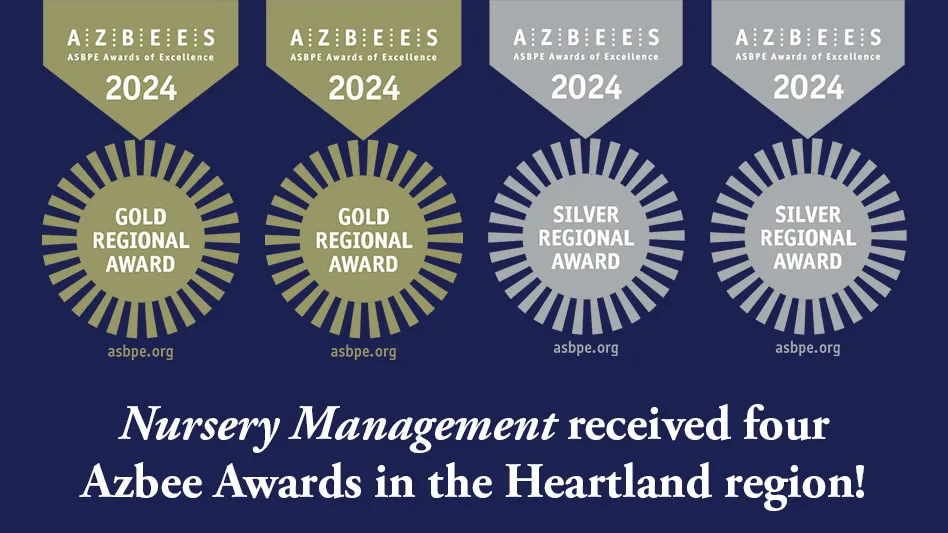 Interest rates remain close to their historical lows but financing for many nurseries continues to be elusive. One problem: lower interest rates have translated into lenders and investors being more selective. How can nursery owners hope to fund the expansion of their operations?
Interest rates remain close to their historical lows but financing for many nurseries continues to be elusive. One problem: lower interest rates have translated into lenders and investors being more selective. How can nursery owners hope to fund the expansion of their operations?
Any quest for expansion funding must begin with an understanding of the various types of financing, where that funding may be found and at what cost. Generally, there are two basic ways to fund expansion: debt financing or equity financing.
With debt financing capital is received in the form of a loan which must be paid back. With equity financing, capital is received in exchange for part ownership in the nursery business.
Equity financing
Equity financing can come from a variety of sources, including the growing operation itself, the owner’s pockets, as well as from private investors. Remember, however, keeping control of your business is more difficult when outside investors are involved.
Equity financing for growth or expansion is more straightforward than subordinated debt financing as investors need only be persuaded that the expansion will increase the equity value of the operation above the price the investor is purchasing his equity today.
Today’s angels
Getting expansion funding from venture capital firms is a long shot for most nurseries. There are a number of other sources, however, including so-called “angel” investors, that can be tapped for equity financing.
A term originally used to describe investors in Broadway shows, “angel” now refers to anyone who invests his or her money in an entrepreneurial company (unlike institutional venture capitalists who invest other people’s money). Angel investing has soared in recent years as a growing number of individuals seek better returns on their money than they can get from traditional investments.
Those who provide services to the nursery operation, such as lawyers, insurance agents or accountants, are often classed as angels. Angels may also be those that the business or its owner, are in regular contact with, such as: suppliers/vendors, customers, employees and even the competition.
A new type of angel investing, so-called “crowd funding,” is replacing more traditional fundraising techniques with a casual, yet powerful, approach based on crowd participation. Even better, although large-scale crowdfunding was not previously permitted under federal securities regulations, today investors can receive equity (i.e. a “share” of ownership in the business), or bonds (i.e. providing a small loan to the business) depending on what the nursery business chooses to offer.
By advertising on websites, called “funding portals,” those needing funds can now reach out directly to investors in both special projects and the business itself.
ESOP is no fable
Unlike crowdfunding, selling stock in a nursery operation does not have to involve strangers. Selling company stock to the operation’s employees through an “Employee Stock Ownership Plan” or ESOP is an often overlooked and usually misunderstood option.
With an ESOP, the incorporated nursery issues new shares of stock and sells them to an ESOP. The ESOP then borrows funds to buy the stock. The nursery business can use the proceeds from the stock sale to its own benefit – growth or expansion.
The loan is repaid with the company’s tax-deductible contributions to the ESOP. The interest and principal on ESOP loans are tax-deductible which can reduce the number of pre-tax dollars needed to repay the principal, depending on the operation’s tax bracket. Remember, however, the tax shield does not help with S corporations since they don’t pay corporate income taxes.
DIY
A surprising number of businesses today have funds available after paying all of their bills – including taxes. One use for those unused profits is to distribute earnings to stockholders in the form of cash dividends. Seldom, however, are all earnings paid out as dividends. Usually a portion is kept to finance future growth.
More often retained earnings are largely only wishful thinking. In fact, expanding with internally-generated funds can be a very difficult process to plan for and implement. The main consideration, obviously, is whether the business has sufficient internal cash flows to pay for expansion outlays.
Often growth requires additional working capital to finance purchases and accounts receivable that may grow faster than payables, putting the nursery or garden center in a tight cash position. If this growth follows historic patterns, and is built on business relationships roughly similar (at least as to creditworthiness) as the operation’s current base, a revolving line of credit can generally be expanded to accommodate the new credit needs of the business.
Borrowing for expansion
In addition to those loans a business often receives from its owner, there are a variety of other funding options available from a number of sources. A bank is probably the best-known source of funds for most nursery businesses.
Typically, banks are the place to go for short-term lending, usually secured by tangible assets. In other situations, however, banks often help in either of two basic ways. First, commercial banks can help a business increase production or output by providing funds to secure new equipment, machinery, vehicles and other instruments and devices. The second area where banks can help is with working capital lines of credit to help it expand and improve cash flow.
Uncle’s helping hand
Often thought of as a lender of last resort, the U.S. government is actually an excellent source for a wide variety of economical financing. Because the federal government has a vested interest in encouraging the growth of small businesses some loans, particularly those of the Small Business Administration (SBA) have less stringent requirements for owner’s equity and collateral. In addition, many SBA loans are for smaller sums than most banks are willing to lend.
7(a) LOANS: The biggest, and most popular SBA loan program, is the 7(a) Loan Guarantee Program for eligible borrowers starting, acquiring and expanding a small business. Although borrowers apply through a participating lending institution, the SBA will guarantees up to $750,000 or 75 percent of the total amount, whichever is less. For loans of less than $100,000, the guarantee usually tops out at 80 percent of the total loan.
The 7(a) program also offers several specialized loans including the “LowDoc” Program for fast processing for amounts under $100,000. This program relies heavily on the grower’s personal credit rating and the nursery or garden center’s cash flow.
504 LOAN PROGRAM: At the top end of the SBA loan size spectrum is the 504 Loan Programs which provides long-term, fixed rate loans for financing fixed assets, usually real estate and equipment. 504 loans are usually made through Certified Development Companies (CDCs) – nonprofit intermediaries that work with the SBA, banks and businesses looking for financing.
Those growers seeking funds of up to $750,000 to buy or renovate a building or buy some major equipment, bring the operation’s business plan and financial statements to a CDC. Typical percentages for this type of package are 50 percent financed by the bank, 40 percent by the CDC and 10 percent by the business – or its owner.
In exchange for this below-market, fixed rate financing, the SBA expects the nursery business to create or retain jobs or to meet certain public policy goals such as an Enterprise/Empowerment Zone, a minority-owned business, etc.
MICROLOANS: The SBA’s “Microloan” Program offers very small loans to start-up, newly established or growing small business concerns. The SBA makes funds available to nonprofit community based lenders which, in turn, make loans to eligible borrowers in amounts up to a maximum of $50,000. Applications are submitted to the local intermediary and all credit decisions are made on the local level.
Funding locally
One of the best sources of assistance – and in many cases funding for expanding nursery operations – are the many state, regional and local economic development agencies. There are nearly 12,000 economic development groups in the U.S. The purpose of these groups is to provide economic growth and development in the areas they serve. They generally encourage new or expanding businesses to locate in their area – or to remain in the area.
Even those who are aware of public funding often have misconceptions about who will and will not qualify. Many of these programs are looking for businesses with proven track records. The state, regional and local agencies are willing to help them expand their sales, which in turn will help expand the tax base and increase employment.
While not always a source of expansion financing, a state’s office or agency of economic development can be a guide to regional and local funding.
How many nursery owners have failed to grow or expand their businesses because of a fear of “over-extending” themselves? Often this fear exists simply because the business’s owners are not aware of the tremendous number of financing options available to their expanding and growing business.
Obviously, financing the growth of a nursery is a complex affair. Funding to help grow and expand the operation is, however, widely available to those growers willing to do their homework. Comparison shopping for lenders, rates and terms is strongly recommended.
Mark Battersby is a freelance writer in Pennsylvania. His tax and financial features have appeared in leading business magazines and trade journals for more than 25 years.

Explore the April 2014 Issue
Check out more from this issue and find you next story to read.
Latest from Nursery Management
- Registration opens for Darwin Perennials Day
- April 2024 issue recap
- U.S. Department of Labor finalizes farmworker protection rule
- Azo Root is now available from Harrell’s
- Smith Gardens assumes operations of Skagit Horticulture
- Garden Media Group announces the fifth annual Women in Horticulture Week
- Eason Horticultural Resources announces the addition of Phil Perry
- Perennial Plant Association celebrates 40th anniversary





